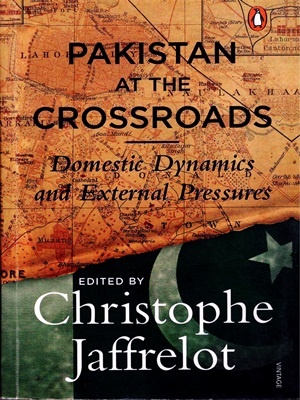The application of an appropriate strategy for addressing internal security challenges while dealing adequately with external pressures has become a major problem of Pakistan, and a topic of immense importance for the international community. The existential threats of ethno–religious strife from inside have inaugurated a critical debate globally on Islamabad’s contemporary standing in the region. The contesting voices of academic world are actively engaged in examining Pakistan’s relations with neighboring states and the Muslim world. Several intellectual efforts from different regions have tried to explore Islamabad’s national security problems by analyzing the domestic issues parallel to external pressures. Christophe Jaffrelot’s recent book is an endeavor to provide an updated account of Pakistan’s security issues by adopting a historically analytical model.
The director of Centre d’études et de recherches internationales (CERI) and Centre national de la recherche scientifique (CNRS) in France, Christophe Jaffrelot has acquired substantial knowledge on politics of South Asia. While serving academically in Paris and London independently, Jaffrelot contributed his writing in various newspapers. The South Asian expertise of French national Jaffrelot has expressed his rational insights in several books, various research papers and numerous opinion articles. His newly published book Pakistan at the Crossroads: Domestic Dynamics and External Pressures is a supplement work following by a detailed analytical description of Pakistan’s problems in French language The Pakistan Paradox: Instability and Resilience (2015). The book published last year tries to provide various paradoxes of Islamabad’s political instability, economic crisis and social unrest. Prior to both studies, Jaffrelot has expressed his thoughts on Pakistan under Pakistan: Nationalism without a Nation? (2002) and A History of Pakistan and its Origins (2004).
The recently issued fourth account on Pakistan is an edited work of Jaffrelot which divides eleven chapters in two parts: The Domestic Scene and The International Dimensions respectively. A group of writers from diverse regions present their academic interpretations of different national security issues of Islamabad in both portions of the book. The concise approach of book mainly called Pakistan as a pivotal state located at crossroad of East–West. The strategic culture of South Asia coupled with the role of extra–regional players has pushed Pakistan into serious crisis where Islamabad is trying to secure a stable future in the region which is essential for its survival. The ideological association with the Muslim world has further pressed Islamabad between antagonistic forces of sectarian politics and an overwhelming wave of religious militancy. Jaffrelot attempts to contribute his argument in existing debate of Pakistan which is calling the country as a garrison–state, ideological–state, security–state, and client–state.
The first part of the book starts discussion from Aqil Shah’s commentary on political contest and a civil–military disturbed equilibrium in Pakistan. The third chapter highlights the role of the judiciary which significantly evolved as a result of civil– military confrontation. Philip Oldenburg calls it judicial activism which developed gradually through different phases (p.92). The mutual work of Shahid Javed and Adnan Naseemullah in chapter six focuses the causes of fiscal deficit, high inflation, and rapidly falling foreign direct investment in Pakistan. Both writers associate the economic decline with deteriorating security situation and unstable political order of Islamabad. The main debate of financial crisis focuses the gradual emergence of traditional and non–traditional security threats across the country. The lack of efficient planning, absence of good governance, and surprising growth of political corruption have further augmented the exiting economic turmoil in Pakistan.

The second part of the book highlights the role of external pressures from regional and extra–regional forces. Avinash Paliwal in chapter seven begins discussion from Islamabad–Kabul relations in post 9/11 scenario. The Taliban insurgency across Pak–Afghan border has cracked the Durand Line. The acute Taliban issue is fertilizing a favorable South Asian landscape for ISIS (p.208). The role of US in Afghanistan and Washington’s complex engagement with Islamabad and New Delhi is examined by Jaffrelot himself. China, as a counterbalance force against American involvement in South Asia and Islamabad–Beijing nexus against Washington–New Delhi strategic partnership is the main theme of chapter eight. While discussing China’s strategic interest under Realpolitik model, both authors, Farah Jan and Serge Granger point out the mega economic project Pakistan–China Economic Corridor (CPEC). The ideological connections of Pakistan with Muslim world and various attempts of ideological unity under multilateral frameworks are the main themes of second last chapter of the book. Sana Haroon emphases on Islamabad’s disorganized stance and unclear status between Tehran and Riyadh’s ideological tussle and intolerant behavior which have resulted in sectarian violence in Pakistan.
Islamabad’s determination for political stability, economic development and social prosperity has been ruined by degrading security environment. Four chapters of the book underline the major causes of a worsening security situation. The second chapter introduces the vicious patterns of power politics between different political parties which has weakened the role of a strong parliament (p.64–66) in Pakistan. The unstable political condition of Islamabad has further provided sufficient space to the covert network of various violent entities in the country. The arguments of Mariam Abou Zahab in chapter four and Hassan Abbas in fifth chapter decently attempt to comprehend internal security problems and the role of law enforcement mechanism of Islamabad. India centric defensive policies of Pakistan to neutralize New Delhi’s hegemonic regional ambitions parallel to Indian anti–Pakistani lobbying in international community ends debate in eleventh chapter.
The combination of academic and journalistic elegance of Jaffrelot attempts to provide an inclusive collection of different essays addressing an unprecedented growth of security challenges, political inconsistencies, economic irregularities, and societal variation in addition to ferocious faces of religious contradictions which have caused a fragile political structure equivalent to a fractured social and economic setup across the country. An irresistible wave of such challenges has resulted in Islamabad’s inappropriate responses to external pressures. Jaffrelot’s investigation in the book inspects the rationales behind different incongruous domains of Islamabad’s foreign policy.
The book is a succinct record of Islamabad’s contemporary contest with real internal and external security threats. A critical examination of ongoing crisis in Pakistan and Islamabad’s strategic preferences in reaction to rapidly evolving regional and global order is the central theme of Jaffrelot’s edited volume. The concluding portions of every chapter offer a suitable way forward of discussed problem while forecasting future of certain issue. In short, it is a well–organized, well– structured and well–argued description of Pakistan’s strategic position in the region and international community.





